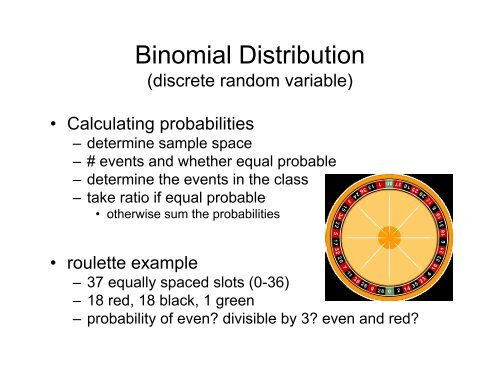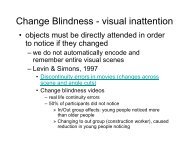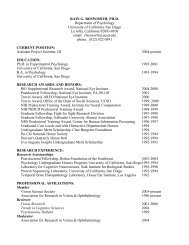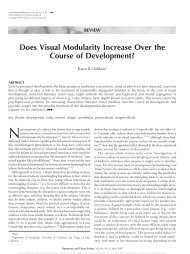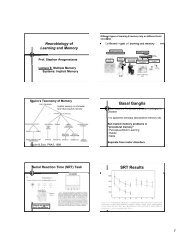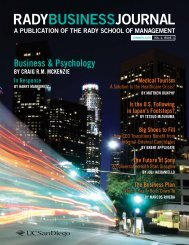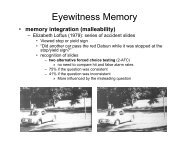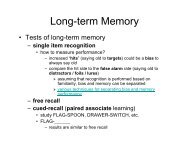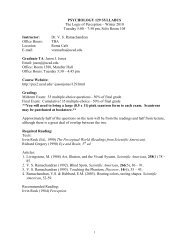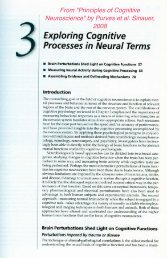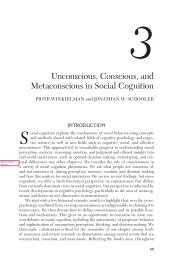Binomial Distribution
Binomial Distribution
Binomial Distribution
Create successful ePaper yourself
Turn your PDF publications into a flip-book with our unique Google optimized e-Paper software.
<strong>Binomial</strong> <strong>Distribution</strong><br />
(discrete random variable)<br />
• Calculating probabilities<br />
– determine sample space<br />
– # events and whether equal probable<br />
– determine the events in the class<br />
– take ratio if equal probable<br />
• otherwise sum the probabilities<br />
• roulette example<br />
– 37 equally spaced slots (0-36)<br />
– 18 red, 18 black, 1 green<br />
– probability of even? divisible by 3? even and red?
Sequences of Events<br />
• A particular sequence of samples (e.g., drawing<br />
marbles)<br />
– joint event across samples<br />
– the sequence can itself be viewed as an elementary event<br />
• Counting rule for N trials of K possible events (sampling<br />
w/ replacement)<br />
– K N possible sequences if K are mutually exclusive and<br />
exhaustive<br />
– Sequences with different K on different trials<br />
• multiply the appropriate K of each trial<br />
• e.g., flipping a coin then rolling a die<br />
• Permutations (sampling w/o replacement)<br />
– ordering N distinct objects<br />
– the number of ordering is N!, where 0!=1<br />
– e.g., 10 students in 10 chairs = 3,628,800<br />
• drawing 2 red then 3 blue marbles?
• Ordered Combinations<br />
– Selecting r objects from N total objects (r ≤ N) when you care<br />
about the order of the r objects (but don’t care about the N-r<br />
remaining objects)<br />
• N! / (N-r)!<br />
• 40 lottery tickets, and 3 winners in order<br />
– # of possible results = ?<br />
• n P r on many calculators<br />
• Unordered Combinations<br />
– “Choosing” r objects from N total objects when you no longer<br />
care about the order in which they’re chosen<br />
⎛N⎞ ⎛N⎞ N !<br />
⎜ ⎟=<br />
⎝ r ⎠ r!( N − r)!<br />
• ⎜ ⎟<br />
⎝ r ⎠is<br />
sometimes called the binomial coefficient<br />
• could be written as nCr • same regardless of which you choose<br />
⎛N⎞ ⎛ N ⎞<br />
⎜ ⎟= ⎜ ⎟<br />
⎝ r ⎠ ⎝N − r⎠
Poker Hands<br />
• how many possible hands?<br />
⎛52⎞ 52!<br />
⎜ ⎟=<br />
= 2,598,960<br />
⎝ 5 ⎠ 5!47!<br />
– roughly 4 in 10 million<br />
• one pair, with 3 different remaining cards<br />
– number of ways to have a pair<br />
– number of ways to have the remaining cards<br />
⎛4⎞ 3 ⎛12⎞ 13⎜ ⎟4⎜ ⎟<br />
2 3<br />
p(one<br />
pair) =<br />
⎝ ⎠ ⎝ ⎠<br />
≈.42<br />
⎛52⎞ ⎜ ⎟<br />
⎝ 5 ⎠<br />
• full house (.0014)? flush? (.00198) nothing?<br />
⎛4⎞ 13⎜ ⎟<br />
⎝2⎠ ⎛12⎞ (4)(4)(4) ⎜ ⎟<br />
⎝ 3 ⎠
Bernoulli Trials<br />
• For Bernoulli process, just two event classes (e.g., coin<br />
flip)<br />
– p = success<br />
– q = failure = 1-p<br />
– stationary versus non-stationary<br />
– not all orders are equally probable (depends on p)<br />
– for independent stationary, the probability of a particular<br />
(ordered) sequence of N trials<br />
• prqN-r , where r is number of successes<br />
• same probability for all orders giving with this number of successes<br />
– often we want to know the probability of r successes, regardless<br />
of order<br />
⎛N⎞ ⎜ ⎟ pq<br />
⎝ r ⎠<br />
• multiply by the number of orders r N−r
<strong>Binomial</strong> <strong>Distribution</strong><br />
• <strong>Binomial</strong> sampling<br />
– typically, N and p are known, and want probability for different<br />
r successes<br />
• By considering all possible numbers of success (0-N),<br />
we can construct the binomial distribution<br />
– parameters, N and p<br />
• the mathematical rule defines a family of particular distributions<br />
⎛N⎞ r N−r px ( = rN ; , p) = ⎜ ⎟ pq , for r= 0,1, 2,..., N<br />
⎝ r ⎠<br />
– examples with 5 coin flips (p=.5) and 5 female college students<br />
(p=.1 married)
Probabilities of Intervals for <strong>Binomial</strong><br />
• for p = .30, N = 10, find p(1 ≤ x ≤ 7)<br />
– same as 1 - p(x = 0, or 8 ≤ x)<br />
– could also list the cumulative<br />
– often we express the binomial in terms of a proportion P = r/N<br />
– appendix F lists binomials (p. 1008), factorials (p. 1028), and<br />
coefficients (1029)
Subliminal Perception<br />
• Guess as to which quadrant a subliminal<br />
point of light is presented<br />
– chance performance is p=.25<br />
– out of 10 trials, 7 are correct<br />
• p(x=7; p=.25, N=10) = .0031<br />
– but even p(x=2) is only .28<br />
• what we want is guessing as compared to having<br />
some information (i.e., x ≥ 7)<br />
– p(x ≥ 7; p=.25, N=10) = .0035<br />
» this is the prob. of “rejecting null hypothesis”<br />
• how would a Bayesian deal with this problem?
Sign Test for 2 Matched Groups<br />
• Use binomial to test for a difference between two matched groups<br />
– e.g., paired/yoked subjects, pre-post test, etc.<br />
• in general is X A (type A) different than X B (type B)?<br />
– for each pair, take the difference x A –x B<br />
– positive differences are +, negative are -, and flip coin for 0 differences (or simply<br />
remove ties and reduce N)<br />
– After training 20 people, 15 improved<br />
• What’s the probability that this would be true if there was no change on<br />
average?<br />
– p(15 or more) = .02<br />
• Can we conclude that the training was effective?<br />
• What if instead we observed improvement in only 5?<br />
– one-tailed versus two-tailed<br />
• Other distributions related to binomial<br />
– geometric: number N needed for r successes<br />
– negative binomial: number of failures before rth success<br />
– Poisson: approximation to binomial with large N and small p<br />
– multinomial: more than 2 outcomes<br />
– hypergeometric: multinomial sampling without replacement


